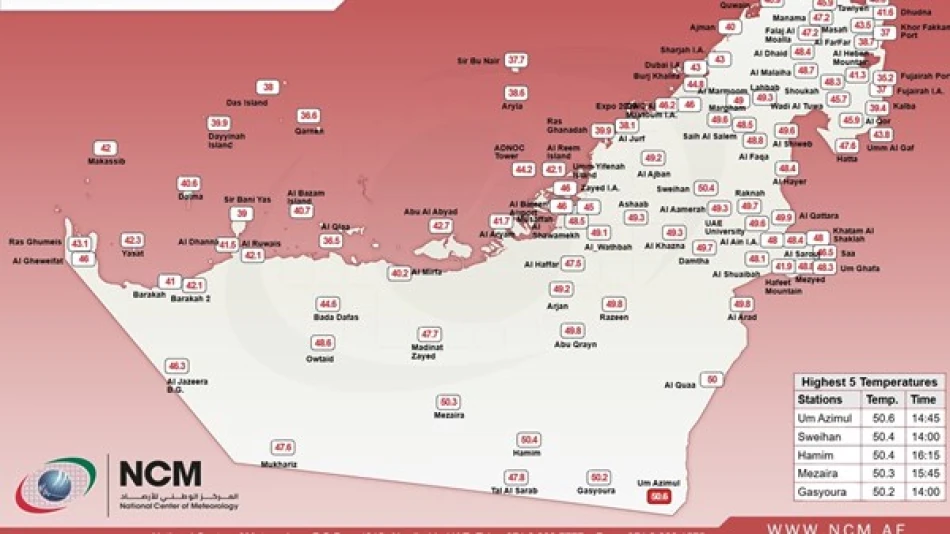
Sizzling Temperatures Hit New Heights: 'Umm Al Zumool' Records Scorching National Record
UAE Swelters as Temperatures Hit 50.6°C, Signaling Peak Summer Intensity
The United Arab Emirates recorded its highest temperature of the year on Thursday, with the mercury climbing to a scorching 50.6°C (123°F) in Um Al Zamool, Al Ain. The extreme reading underscores the Gulf nation's position among the world's hottest regions and highlights the intensifying summer conditions that challenge both residents and the country's energy infrastructure.
Record-Breaking Heat Spreads Across Multiple Regions
The extreme temperatures weren't isolated to a single location. Weather stations across the UAE's interior documented similarly punishing conditions, with Sweihan and Hameem both recording 50.4°C, while Madinat Zayed hit 50.3°C and Jebel Hafeet reached 50.2°C. These readings, taken at 2:45 PM local time, represent the peak heat of the day when solar radiation reaches its maximum intensity.
The widespread nature of these extreme temperatures reflects the broader meteorological pattern affecting the Arabian Peninsula during summer months, when high-pressure systems trap hot air masses over the region.
Weather Patterns Signal Seasonal Transition
Current Conditions and Atmospheric Dynamics
Despite the scorching temperatures, Thursday's weather showed signs of atmospheric instability typical of the UAE's summer transition period. The National Center of Meteorology reported partly cloudy conditions with cumulus cloud formation in eastern regions during afternoon hours. Light to moderate winds, occasionally picking up in western areas, stirred dust and sand particles across the landscape.
Sea conditions remained relatively calm, with light to moderate waves in both the Arabian Gulf and the Sea of Oman, suggesting stable coastal weather patterns despite the inland heat.
Weekend Forecast Brings Hope for Relief
The meteorological outlook for Friday and Saturday offers some respite from the extreme heat. The National Center of Meteorology predicts rainfall across coastal and inland western regions, accompanied by dust-stirring winds that could provide natural cooling effects.
Weekend conditions are expected to feature clear to partly cloudy skies with cumulus cloud development in eastern and southern areas. These formations may produce scattered rainfall, while humidity levels will rise during nighttime and early morning hours, particularly in western coastal and inland regions.
Regional Context and Climate Implications
The UAE's summer temperature patterns align with broader regional trends across the Gulf Cooperation Council states, where temperatures regularly exceed 50°C during peak summer months. However, these readings carry particular significance for the Emirates' energy sector and urban planning initiatives.
Energy Infrastructure Impact: Such extreme temperatures place enormous strain on the UAE's electrical grid, as air conditioning demand peaks during daylight hours. The country's substantial investments in renewable energy, including the world's largest single-site solar park in Dubai, become increasingly critical during these periods.
Economic Considerations: The timing of peak heat coincides with reduced outdoor economic activity, reinforcing the UAE's strategic shift toward indoor, climate-controlled environments for commerce and tourism. This weather pattern supports the country's emphasis on mall-based retail and indoor entertainment complexes.
Looking Ahead: Seasonal Weather Patterns
The current temperature spike represents the typical progression toward the UAE's hottest period, usually occurring between July and early August. Historical data suggests that while 50.6°C is extreme, it falls within the range of maximum temperatures recorded in recent years, indicating consistent climate patterns rather than unprecedented warming.
The forecasted weekend rainfall, while providing temporary relief, also signals the gradual approach of the region's more variable autumn weather patterns, when occasional precipitation becomes more common and temperatures begin their slow descent toward the more moderate winter months.
Most Viewed News

 Layla Al Mansoori
Layla Al Mansoori






